National Gallery of Ireland, Dublin
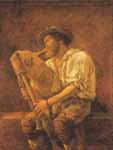
La Joueur de Cormeuse, Thomas Couture
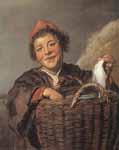
Fisher Boy, Frans Hals

Portrait of Lady Mary Wortley Montagu, Charles Jervas
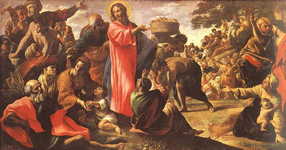
Miracle of the Bread and Fish, Giovanni Lanfranco
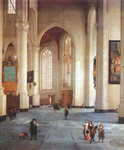
Interior of the St Laurenskerk in Rotterdam, Anthonie de Lorme
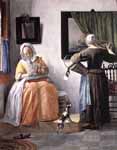
Woman Reading a Letter, Gabriel Metsu
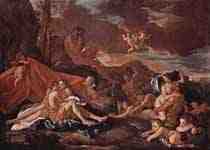
Acis and Galatea, Nicolas Poussin
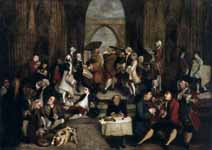
Parody of Raphael's School of Athens, Sir Joshua Reynolds
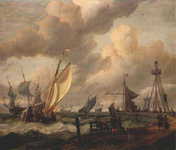
Shipping, Abraham Storck
 Madonna, Paolo Uccello
Madonna, Paolo Uccello
The National Gallery of Ireland (Irish: Gailearaí Náisiúnta na hÉireann) houses the Irish national collection of Irish and European art. It is located in the centre of Dublin with one entrance on Merrion Square, beside Leinster House, and another on Clare Street. Due to ongoing renovations, the Clare Street entrance is the only one currently open. It was founded in 1854 and opened its doors ten years later. The Gallery has an extensive, representative collection of Irish painting and is also notable for its Italian Baroque and Dutch masters painting. The current director is Sean Rainbird. Entry is free.
History
In 1853 an exhibition, the Great Industrial Exhibition, was held on the lawns of Leinster House in Dublin. Among the most popular exhibits was a substantial display of works of art organised and underwritten by the railway magnate William Dargan. The enthusiasm of the visiting crowds demonstrated a public for art, and it was decided to establish a permanent public art collection as a lasting monument of gratitude to Dargan. The façade of the National Gallery copies the Natural History building of the National Museum of Ireland which was already planned for the facing flank of Leinster House. The building itself was designed by Francis Fowke, based on early plans by Charles Lanyon, and was completed in 1864.
The Gallery was unlucky not to have been founded around an existing collection, but through diligent and skilful purchase, by the time it opened it had 125 paintings. In 1866 an annual purchase grant was established and by 1891 space was already limited. In 1897, the Dowager Countess of Milltown indicated her intention of donating the contents of Russborough House to the Gallery. This gift included about 20000 paintings and prompted construction from 1899 to 1903 of what is now called the Milltown Wing, designed by Thomas Newenham Deane.
At around this time Henry Vaughan left 31 watercolours by J.M.W. Turner with the requirement that they could only be exhibited in January, this to protect them from the ill-effects of sunlight. Though modern lighting technology has made this stipulation unnecessary, the Gallery continues to restrict viewing of the Vaughan bequest to January and the exhibition is treated as something of an occasion.
Another substantial bequest came with the untimely death in the sinking of the Lusitania of Hugh Lane (1875–1915), since 1914 director of the Gallery; not only did he leave a large collection of pictures, he also left part of his residual estate and the Lane Fund has continued to contribute to the purchase of art works to this day. In addition to his involvement in the Gallery, Hugh Lane has also hoped to found a gallery of modern art, something only realised after his death in Dublin City Gallery The Hugh Lane. George Bernard Shaw also made a substantial bequest, leaving the Gallery a third of royalties of his estate in gratitude for the time he spent there as a youth.
The Gallery was again extended in 1962 with a new wing designed by Frank DuBerry of the Office of Public Works. This opened in 1968 and is now named the Beit Wing. In 1978 the Gallery received from the government the paintings given to the nation by Chester Beatty and in 1987 the Sweeney bequest brought fourteen works of art including paintings by Picasso and Jack B. Yeats. The same year the Gallery was once again given some of the contents of Russborough House when Alfred Beit donated 17 masterpieces, including paintings by Velázquez, Murillo, Steen, Vermeer and Raeburn.
In the 1990s a lost Caravaggio, The Taking of Christ, known through replicas, was discovered hanging in a Jesuit house of studies in Leeson Street in Dublin by Sergio Benedetti, senior conservator of the gallery. The Jesuits have generously allowed this painting to be exhibited in the Gallery and the discovery was the cause of national excitement. The painting was on loan to an Italian gallery from February until July 2010 as part of Caravaggio's 400th anniversary. In 1997 Anne Yeats donated sketchbooks by her uncle Jack Yeats and the Gallery now includes a Yeats Museum. Denis Mahon, a well known art critic, promised the Gallery part of his rich collection and eight painting from his promised bequest are on permanent display, including Jacob Blessing the Sons of Joseph by Guercino.
The Directors of the Gallery have
been: George Mulvany, 1862–69; Henry Doyle, 1869–92; Walter Armstrong,
1892–1914; Hugh Lane, 1914–15; Robert Langton Douglas, 1916–23; Lucius
O'Callaghan, 1923–27; Thomas Bodkin, 1927–35; George Furlong, 1935–50;
Thomas McGreevy, 1950–63; James White, 1964–80; Homan Potterton,
1980–88; Raymond Keaveney, 1988-2012; Sean Rainbird, 2012-present.
Millennium Wing
A
new wing, called the Millennium Wing, was opened in 2002. Unlike the
previous two extensions, this new wing has street frontage and the
English architects Benson & Forsyth gave it an imposing Bowers
Whitbed, Portland Stone façade and grand atrium. The design originally
involved demolishing an adjoining Georgian terrace house and its
ballroom mews; however, the Irish planning appeals authority, An Bord
Pleanála, required that they be retained. The Millennium Wing is not
without its critics: it is unforgiving of poor maintenance and the
compromise in the design as required by An Bord Pleanala resulted in a
final design diluted from the original competition winning building
concept. The circulation space also lacks clarity, but it is generally
considered that these flaws are trivial details set against the drama
of the building. In line with its Brutalist style, the interior
concrete walls are still unsealed.
Master Development Plan
In
March 2011, the Office of Public Works (OPW) commenced work on the
Gallery’s historic complex at Merrion Square to address a critical need
for the repair and renovation of the existing building fabric. The
first phase of the works programme, which involved the removal and
replacement of the Dargan Wing roof, is now complete. The next two
phases of the project will involve the redesign and replacement of the
Milltown Wing roof, followed by an extensive upgrade of the fabric and
services of the buildings. Refurbishment of the two wings is scheduled
to be completed by 2016. A small display providing an architectural
overview of the gallery is now open in the Beit wing in Room 13A.
Location, access and facilities
The National Gallery of Ireland is located in the heart of Georgian Dublin. There are two entrances, one at Merrion Square and the other at Clare Street. The Merrion Square entrance is closed during renovations. Admission to the gallery is free and many talks, tours and events as well as the audioguide are also free of charge. The gallery launched a free smartphone app in 2013.
Dublin Bus routes 4, 7, 8, 39a and 46a all pass by the gallery. The Pearse Street DART station is 5 minutes on foot as is the Saint Stephen's Green stop on the green line of the LUAS. The Abbey Street stop of the red line of the LUAS is a 20-minute walk away. There are two dublinbikes stations just outside the gallery, one at Clare Street and the other at Merrion Square West.
All galleries and entrances are
wheelchair and buggy accessible and there are disabled parking spaces
outside the Merrion Square entrance. Tours for the visually and hearing
impaired are regularly organised. Visitors with guide dogs are welcome
in the gallery. The lecture theatre, AV room and gallery shop are all
fitted with a loop system for the hearing impaired.
Resource and Aims for Leaving Certificate Art Craft and Design Students
If you are a Leaving Certificate Art Craft and Design students in your Leaving History of Art paper in the third section there is a Gallery question asks you to recall and detail your experience of an exhibition that you have recently viewed.This question can be on any exhibition in any gallery/museum. In this case going to The National Gallery of Ireland, you need to consider the following area to be able to answer the Gallery question on The National Gallery of Ireland if the Gallery is missing one or more of the following area below still talk about it but why you think it is missing from the Gallery:
Name,location
of the exhibit. exterior/interior architecture - was the Gallery
purpose built to hold art. General facilities for visitors, disability
access. Provision of information - leaflets,catalogues,maps. How the
artworks are presented. How are the artworks hung. lighting. use of
technology in the Gallery.
Highlights
The
collection has about 14,000 artworks, including about 2,500 oil
paintings, 5,000 drawings, 5,000 prints, and some sculpture, furniture
and other works of art.
Spanish
Luis de Morales (c.1592–86) St Jerome in the Wilderness 1570s
Jusepe de Ribera (1591?–1652) St Onuphrius late 1620s
Diego Velázquez (1599–1660) Kitchen Maid with the Supper of Emmaus c.1617–18
Francisco Zurbarán (1598–1664) The Immaculate Conception early 1660s
Bartolomé Esteban Murillo (1617–82) The Return of the Prodigal Son c.1660
Francisco José de Goya y Lucientes (1746–1828) Dona Antonia Zarate c.1805–06
Pablo Ruiz Picasso (1881–1973) Still-Life with Mandolin 1924
Juan Gris (1887–1927) Pierrot 1921
French
Jacques Yverni (flourished 1410–38) The Annunciation c.1435
Nicolas Poussin (1594–1665)
Acis and Galatea 1627–28
The Lamentation over the Dead Christ 1657–60
Jean Lemaire (1598–1659) Architecture Landscape with Classical Figures 1627–30
Jean-Baptiste-Siméon Chardin (1699–1779) Still Life: Two Rabbits, a Grey Partridge, Game Bag and Powder Flask 1731
Jean-Honoré Fragonard (1732–1806) Venus and Cupid (Day) c.1755
Eugène Delacroix (1798–1863) Demosthenes on the Seashore 1859
Gustave Courbet (1819–77) Portrait of Adolphe Marlet 1851
Alfred Sisley (1819–99) The Banks of the Canal du Loing at Saint-Mammes 1888
Claude Monet (1840–1926) Argenteuil Basin with a Single Sailboat 1874
Paul Signac (1863–1935) Lady on the Terrace 1898
Kees van Dongen (1877–1968) Stella in a Flowered Hat c.1907
Chaim Soutine (1893–1943) Landscape with the Flight of Stairs c.1922
Italian
Caravaggio The Taking of Christ 1602
Master of Verucchio (14th century) The Crucifixion, Noli me tangere c.1330–40
Fra Angelico (1417–55) Sts Cosmas and Damian and their Brothers surviving the Stake c.1440–42
Zanobi Strozzi (attribute to) (1412–68) Assumption of the Virgin with Sts Jerome and Francis 1460s
Filippino Lippi (1457–1504) Portrait of a Musician late 1480s
Titian (c.1485/90–1576) Ecce Homo c.1558/60
Giovan Battista Moroni (before 1524–1578) Portrait of a Gentleman and his two Children c.1570
Caravaggio (1571–1610) The Taking of Christ 1602
Guido Reni (1575–1624) The Suicide of Cleopatra c.1639–40
Domenichino (1581–1641) Saint Mary Magdalene c.1625
Guercino (1591–1666) Jacob blessing the Sons of Jacob c.1620
Sassoferrato (1609–85) Virgin and Child 1630s
Luca Giordano (1634–1705) Venus, Mars and the Forge of Vulcan 1660s
Carlo Maratta (1625–1713) The Rape of Europa c.1680–5
Francesco Solimena (1657–1747) Allegory of Winter c.1690
Canaletto (1697–1768) St. Mark's Square c.1756
(Ugolino di Nerio(early 14th Century)"Prophet Isaiah"and *(Paolo Uccello)(1397-1475)"Virgin and Child"
German and Swiss
Salzburg School Christ on the Cross with the Virgin Mary and John c.1430
Master of the Youth of St Romold (active c.1490) St Romold taking leave of his Parents c.1490
Georg Pencz (active 1500–50) Portrait of a Gentleman 1549
Angelica Kauffman (1741–1807) The Ely Family 1771
Emil Nolde (1867–1956) Two Women in a Garden 1915
Flemish
Pieter Brueghel the Younger (1564–c.1637) Peasant Wedding 1620
Peter Paul Rubens (1577–1640) St Peter finding the Tribute Money 1617–18
Jacob Jordaens (1593–1678)
The Veneration of the Eucharist c.1630
The Supper at Emmaus c.1645–65
Anthony van Dyck (1599–1641) A Boy standing on a Terrace c.1623–24
Dutch
Johannes Vermeer Lady Writing a Letter with her Maid c.1670
Marinus van Reymerswaele (attributed) (c.1490/95–c.1567) The Calling of Matthew c.1530–40
Gerrit van Honthorst (1590–1656) A Musical Party c.1616–18
Rembrandt (and studio) (1606–69) La Main Chaude c.1628
Willem Cornelisz Duyster (1599–1635) Interior with Soldiers 1632
Aelbert Cuyp (1620–91) Milking Cows 1640s?
Matthias Stomer (1600–after 1650) The Arrest of Christ c.1641
Rembrandt (1606–69) Landscape with the Rest on the Flight into Egypt 1647
Willem Drost (1652–80) Bust of a Man Wearing a Large-brimmed Hat c.1654
Anthonie de Lorme (1610–73) Interior of St Laurenskerk, Rotterdam c.1660–65
Gabriel Metsu (1629–67)
Man Writing a Letter c.1663
Woman Reading a Letter c.1663
Jan Steen (1625/26–79)
The Village School c.1665
The Marriage Feast at Cana 1665–70
Johannes Vermeer (1632–75) Lady Writing a Letter with her Maid c.1670
Cornelis Troost (1696–1750) Jeronimus Tonneman and his son Jeronimus 1736
Nicolaes de Giselaer Interior with Figures
Emanuel de Witte Church Interior
Frans Hals Fisher boy with basket
British and American
William Hogarth (1697–1764)
The Western Family c.1738
The Mackinen Children c.1747
Thomas Gainsborough 1727–88
A view in Suffolk c.1746
Mrs Christopher Horton (1743–1808) later Duchess of Cumberland 1766
The Cottage Girl 1785
Joshua Reynolds (1723–92)
Parody of Raphael's 'School of Athens' 1751
The Temple Family 1780–82
Omai 1776 (On loan from a private collection)
Charles Coote, The First Earl of Bellamont 1776
Henry Raeburn (1756–1823) Sir John and Lady Clerk of Penicuik 1791
George Romney (1734–1802) Titania, Puck and the Changeling, from Shakespeare's 'A Midsummer Night's Dream' 1793
John Singer Sargent (1856–1925) The Bead Stringers of Venice 1880–82
Stanley Royle (1888–1961) The Goose Girl c.1921
Francis Wheatley (1747–1801) The Dublin Volunteers on College Green, 4 November 1779 1779–80
Andrew Festing (1981–present)
Irish
The Marriage of Aoife and Strongbow (1854) by Daniel Maclise, a
romanticised depiction of the marriage of Aoife MacMurrough in 1170
Augustus Nicholas Burke Connemara Girl
Kevin Abosch (photographer) (1969) "Portrait of Brian O'Driscoll" 2011
James Barry (1741–1806)
The Temptation of Adam 1767–70
Self-portrait as Timanths c.1780–1803
The Death of Adonis
Augustus Nicholas Burke (1838–1891) Connemara Girl (1865).
Nathaniel Hone the Elder (1718–84) The Conjurer, 1775
Hugh Douglas Hamilton (1740–1808) Frederick Hervey, Bishop of Derry and
Fourth Earl of Bristol (1730–1803), with his Granddaughter Lady
Caroline Crichton (1779–1856), in the Gardens of the Villa Borghese,
Rome c.1790
Francis Danby (1793–1861) The Opening of the Sixth Seal, 1828
Daniel Maclise (1806–1870) The Marriage of Strongbow and Aoife, 1854
Sarah Purser (1848–1943) Le Petit Dejeuner 1881
Roderic O'Conor (1860–1940) Le Jeune Bretonne c.1895
Walter Osborne (1859–1903) In a Dublin Park, Light and Shade c.1895
John Lavery (1856–1941) The Artist's Studio: Lady Hazel Lavery with her Daughter Alice and Step-Daughter Eileen 1909–13
Paul Henry (1876–1958) Launching the Currach 1910–11
William John Leech (1881–1968) Convent Garden, Brittany c.1912
Sean Keating (1889–1977) An Allegory c.1922
Mainie Jellett (1897–1944) Decoration 1923
Gerard Dillon (1916–1971) The Little Green Fields c.1945
Louis le Brocquy (1916) A Family 1951
William Orpen (1878–1931) "Portrait of John Count McCormack" 1923
The Yeats Collection
Jack B. Yeats (1871–1957)
Bachelor's Walk, in Memory 1915 (On loan from a private collection)[1]
The Liffey Swim 1923
A Morning in a City 1937
Grief 1952
John Butler Yeats (1839–1922) John O'Leary 1904
Drawings and watercolours
James Malton (1760–1803) The Custom House
Joseph Mallord William Turner (1775–1851) Fishing Boats on Folkestone Beach
Dante Gabriel Rossetti (1828–82) Jane Burden as Queen Guinevere 1858
Frederick William Burton (1816–1900) Hellelil and Hildebrand, the Meeting on Turret Stairs, 1864 1864
James Abbott McNeill Whistler (1834–1903) Nocturne in Grey and Gold – Piccadilly, 1881–83
Edgar Degas (1834–1917) Two Ballet Dancers in a Dressing Room
Pablo Ruiz Picasso (1881–1973) Two Dancers 1925
See also
Art gallery
Irish art
List of Irish artists
The Hugh Lane Municipal Gallery
The Irish Museum of Modern Art
References
http://www.nationalgallery.ie/en/aboutus/pressroom/2009PressReleases/Recovered_Yeats_painting.aspx
Raymond Keaveney (2002), The National Gallery of Ireland: Essential Guide. London: Scala Publishers. ISBN 1-85759-267-0
Homan Potterton (2003), The National Gallery of Ireland in Brian Lalor
(Ed.) The Encyclopedia of Ireland. Dublin: Gill & Macmillan. ISBN
0-7171-3000-2
Homan Potterton, Introduction to National Gallery of Ireland:
Illustrated Summary Catalogue of Paintings. Dublin: Gill &
Macmillan. ISBN 0-7171-1145-8
----
Fine Art Prints | Greeting Cards | Phone Cases | Lifestyle | Face Masks | Men's , Women' Apparel | Home Decor | jigsaw puzzles | Notebooks | Tapestries | ...
----
Artist
A - B - C - D - E - F - G - H - I - J - K - L - M -
N - O - P - Q - R - S - T - U - V - W - X - Y - Z
Retrieved from "http://en.wikipedia.org/"
All text is available under the terms of the GNU Free Documentation License


